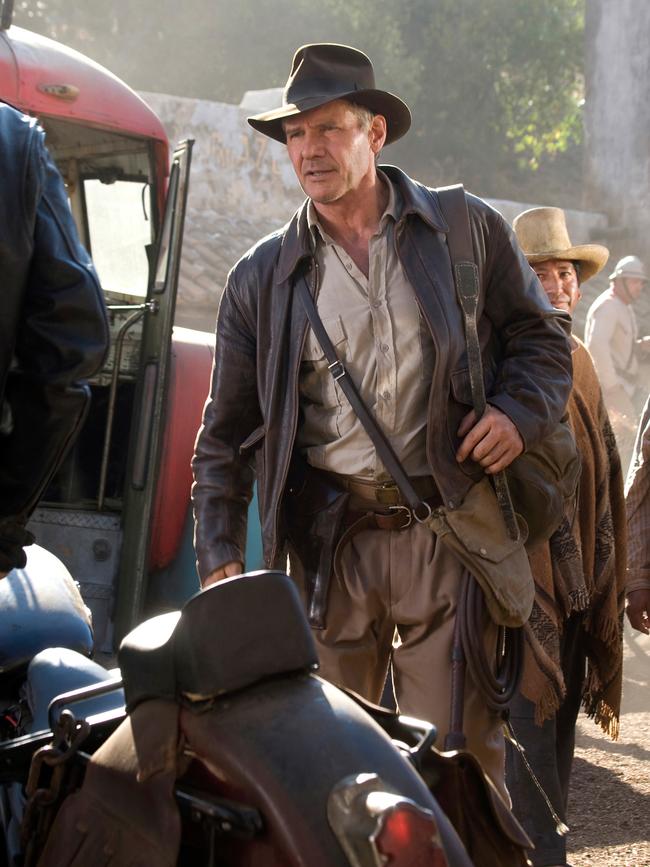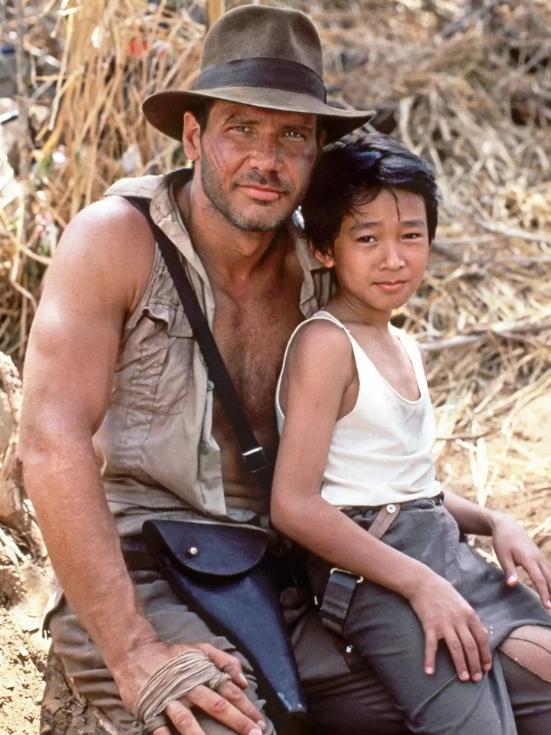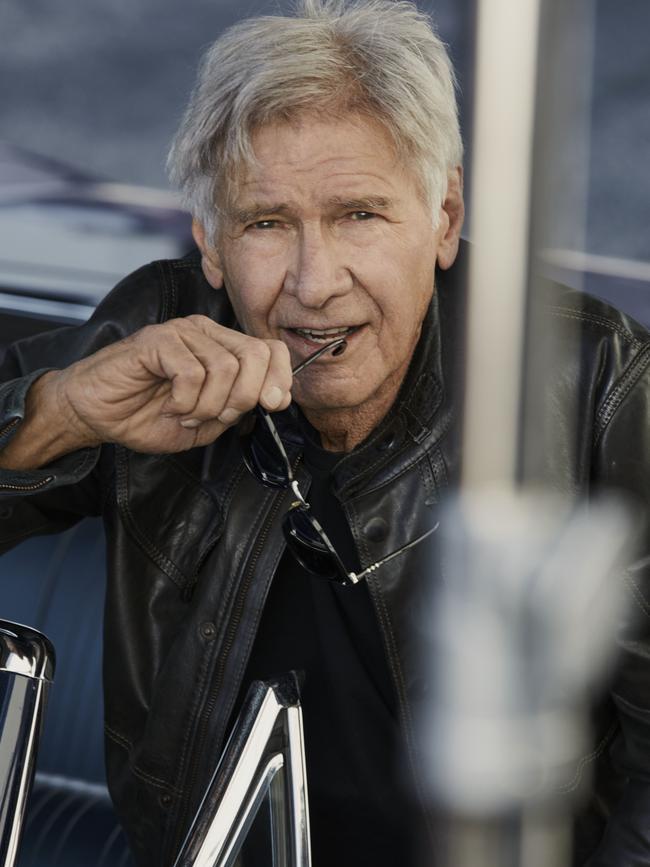When Harrison Ford was offered the role of Indiana Jones in Raiders of the Lost Ark, he jumped at the chance because it presented an opportunity to work with director Steven Spielberg and producer George Lucas, and because the story was a throwback to 1930s and ’40s action and adventure films.
“I could see an opportunity to have a lot of fun, to bring a character to life in the context of a world that I understood: to be the world of movies,” Ford, 80, says in that unmistakably deep gravelly voice in the first of two interviews with Review via Zoom last week.
“The movie is more about movies and the fun you can have in movies than it is about archaeology. And I sensed right away that with the combination of Steven and George, and the script that Larry Kasdan had written, I felt like I had stumbled into a pot of gold.”
We have seen Dr Henry Jones Jr, an archaeology professor who encourages students to get out of the library and into the field, chased by a giant boulder, tortured with voodoo, brush off creepy-crawlies, and fight Nazis and Soviets, while he is inevitably doublecrossed hunting for ancient relics that belong in a museum.
Along the way, Indiana Jones has been punched, kicked, shot at, dodged poisoned darts, arrows and bullets. He has leapt from aeroplanes, crashed cars and motorbikes, run atop trains and ridden horses, all set to John Williams’ elevated score which makes the heart beat faster. “Da-da-da-dah, dah-dah-dah …”
The Indy image is iconic: clad in brown light wool trousers, a khaki two-pocketed shirt and brown leather jacket, with stylish wide-brimmed high-crowned fedora hat, bullwhip and pistol by his side, and satchel to keep those valuable artefacts safe from villains who would use them to command paranormal powers.
“It is movie making like it used to be: real human stories, real adventure, real action without gore, real contest without too much unnecessary conflict,” Ford says. “They are such brilliant combinations of the elements of joy, about human contact and the importance of getting your life right.”
Indy is a reluctant, multi-layered, hero. A panicked look of fear in his eyes can turn to steely resolve in an instant. He is determined but not fearless. He is terrified of snakes. “Snakes. Why did it have to be snakes?” When in a tight spot, he uses wit, charm or brute force to get out of it. His resigned acceptance to a bad situation is always leavened by a dry, wisecracking humour and crooked smile.
Raiders of the Lost Ark (1981), set in 1936, was a box office smash and still ranks among the greatest films made. It spawned a prequel set in 1935 – Indiana Jones and the Temple of Doom (1984) – followed by Indiana Jones and the Last Crusade (1989) set in 1938 and then, after a long hiatus, Indiana Jones and the Kingdom of the Crystal Skull (2008) set in 1957.
Now he is back for a fifth and final thrilling adventure in Indiana Jones and the Dial of Destiny, set mostly in 1969, directed by James Mangold and co-starring Phoebe Waller-Bridge, Mads Mikkelsen, Antonio Banderas and Toby Jones. Familiar faces return and there are nostalgic callbacks to the earlier films as he travels the globe, always marked by a red line on a map.
I enjoyed every minute of the new film, having seen it twice, including on the final night of the Sydney Film Festival. It offers a compelling story that is visually stunning, cleverly directed and superbly acted, that combines to make a heart-pumping adventure with action, drama, humour and heart.
Ford, who turns 81 next month, is one of Hollywood’s greatest movie stars, and certainly among the most bankable. The roll call of films is extraordinary: the Star Wars series (1977-2015); Blade Runner (1982; 2017), the Jack Ryan spy thrillers (1992; 1994), and classic pictures Witness (1985), The Fugitive (1993) and Air Force One (1997), among others.
I was a wide-eyed six-or-seven-year-old watching Raiders on a small home television. I remember going with friends to see Temple of Doom when I was eight and Last Crusade when I was 13 – both cinematic events imprinted in my memory. I nervously confessed to being overwhelmed as Ford appeared on screen for our interview, waiting for me to ask questions.

In the two interviews – one as a roundtable with three other journalists – Ford was friendly, engaging and thoughtful. He has a reputation for being grumpy at times but showed none of this. He comes across as a deep thinker, grateful for his career and family (three wives and five children), who makes careful choices about acting roles.
“I’ve been the luckiest actor in the world to have stumbled into this kind of storytelling, to work with these kinds of directors, to bring this kind of joy to an audience,” Ford tells me. But he insists that one actor does not make a great movie. “I’m a part of a very large machinery,” he says.
After studying acting in college, Ford scored minor theatre, television and film roles – mainly westerns and cop shows – in the late 1960s and early ’70s. He explains that he only took up carpentry to pay the bills between irregular acting jobs.
“It’s been an incredible journey,” Ford reminisces. “I understood at a certain point that if I kept doing the same kind of television shows that I was doing, which was all that was available to me, I was afraid I was going to wear out my face before I had a chance to do the kind of work I wanted to do, which was film.”
He secured supporting roles in Lucas’s American Graffiti (1973) and Francis Ford Coppola’s The Conversation (1974). He was 34 when Star Wars opened. The road to “fortune and glory”, as Indy would say, took time.
“I’ve had enormous luck,” Ford says. “So much of my success is based on other peoples’ success and I’m so grateful for that. But my advice to younger artists is very simple: don’t try and imitate anyone else’s success. Find it in yourself. It’ll always be there. Use yourself, what you really feel, what you really know, how you bring that as a gift, as an offering, to the story.”

He has portrayed Han Solo, Rick Deckard and Jack Ryan in multiple films. But he has been Indiana Jones more than anyone else. Contrary to fan legend, it is not his favourite character.
“I don’t have favourites,” Ford clarifies. “I don’t have a favourite film or filmmaker.” He says it is about giving the audience the best performance he can: “That means making choices about the stories that I tell, the people that I work with, and I would not have that freedom if it weren’t for the pleasure that the audience has had with these films.”
Ford has returned to television with critically acclaimed roles in Taylor Sheridan’s western epic 1923 alongside Helen Mirren, and the dramedy Shrinking with Jason Segel. He will finally appear in a superhero movie, Captain America: Brave New World, next year.
“What I am looking for, as I’ve always looked for, are great stories, great collaborators, ambitious projects, things I haven’t done before,” Ford says. “I ran into a vein of really good writing with Shrinking, with 1923, with Indiana Jones, and even in the Marvel Universe … which I cannot resist wanting to be part of.”
* * *
Spielberg, flush with the success of Jaws (1975) and Close Encounters of the Third Kind (1977), wanted to direct a James Bond movie. Lucas, who wrote and directed Star Wars, told Spielberg he had a better idea: Indiana Smith. Lucas developed the character, renamed Indiana Jones, and served as co-executive producer.
It is impossible to imagine anyone else in the role, but Lucas was reluctant to cast Ford given they had previously worked together. Tom Selleck, then starring in Magnum, P.I. (1980-88), tested for the role and got it. A mustachioed Indy was in the making. But CBS would not release Selleck from his television contract. Ford was cast. “I was grateful that Tom Selleck had another job,” he jokes.
The secret to the films is the “MacGuffin” – an object that drives the story and keeps our hero on his quest. It is the Ark of the Covenant, the Sankara Stones, the Holy Grail, an otherworldly crystal skull and now, Archimedes’ dial of destiny, the Antikythera mechanism, which identifies fissures in time. It is always the supernatural grounded in the historical.
Raiders is, for many, the ultimate Indiana Jones film. What can compete with Indy snatching a golden fertility idol from a Peruvian temple as booby-traps are set off and a giant boulder hurtles towards him? Here we meet our reluctant and relatable hero. “I’m making this up as I go,” he later says.


Or the opening of Temple of Doom set at Shanghai’s Club Obi Wan (a nod to Star Wars), as Indy escapes from Lao Che, boards a plane and then jumps out in an inflatable raft with Willie Scott (Kate Capshaw) and Short Round (Ke Huy Quan) before it crashes. Or the dinner of snake surprise, eyeball soup and monkey brains at Pankot Palace? Or the rope bridge that Indy slices in half? And the mine cart chase?
Last Crusade – my favourite – saw Indy join with his father (Sean Connery) and reunite with Marcus Brody (Denholm Elliott) and Sallah (John Rhys-Davies). “You call this archaeology?” Dr Henry Jones Sr asks. River Phoenix plays the young Indy and we understand his fear of snakes and see his first crack of a whip, and learn how he gained a chin scar. The clues in the father’s diary and the tests he must pass before reaching the Holy Grail are enthralling.
Kingdom of the Crystal Skull has gripping moments too. Indy survives a nuclear detonation by hiding in a lead-lined refrigerator, weds Marion Ravenwood (Karen Allen), discovers his son Mutt Williams (Shia LaBeouf) and battles Irina Spalko (Cate Blanchett) in a story inspired by the crashed alien spacecraft at Roswell in 1947. While critics gave mixed reviews, it made a huge $US790m at the box office.

In all of these adventures, Ford clarifies, he is an actor not a stunt performer. “I don’t do stunts; stunt people do stunts,” he says. “I do physical acting: running, jumping, falling down, fist fights, rolling around on the floor with sweaty men. Stunts are different. Stunts can hurt.”
Mangold, who takes over the directing reins from Spielberg, describes the series as a love letter to the golden age of filmmaking. “Each movie stakes out its own ground and its own themes (but) operates within the rule book for what is an Indiana Jones film,” he tells me. “But at the same time, expanding that universe and that playground of what can be.”
The first 25 minutes of Dial of Destiny features a digitally de-aged Ford in an exhilarating vintage flashback to 1944. The film then gallops forward to 1969, where we see an older Indy on the verge of retirement from teaching. “It’s not the years, honey, it’s the mileage,” as Indy says. Seeing an older Dr Jones was important to Ford.
“A character that depended on his vigour and his energy and his passion, we now see, with the ravages of age, somewhat dispirited, a bit broken,” Ford says. Helena Shaw (Waller-Bridge) reinvigorates him for “a grand adventure” in a race against time with an old enemy in pursuit. “Nazis. I hate those guys,” Indy reminds us.
Ford wants people to see the film that sends our hero into Hollywood history in a cinema where “human emotion” is shared. “I want people to feel a renewed sense of value in how one lives their life,” he adds. “There’s a wonderful emotional context that I especially value in the character’s story at the very end of this film.”
Indiana Jones has enduring appeal. I watched the films with my parents and now with my children. Ford is especially proud that these are family films that span the generations with timeless themes and values. But it is time to hang up the hat.
“It’s been a very, very gratifying experience to be Indiana Jones,” Ford tells me. “I love the fact that I have lived different lives. I’ve had the chance to explore different characters, different lives. That to me is the joy of having only one life to live as Harrison Ford but 40 lives to live as an actor.”
Indiana Jones and the Dial of Destiny is in cinemas from June 28.



More Coverage
Troy Bramston has been a senior writer and columnist with The Australian since 2011. He has interviewed politicians, presidents and prime ministers from multiple countries along with writers, actors, directors, producers and many pop-culture icons. Troy is an award-winning and best-selling author or editor of 12 books, including Gough Whitlam: The Vista of the New, Bob Hawke: Demons and Destiny, Robert Menzies: The Art of Politics and Paul Keating: The Big-Picture Leader. Troy is a member of the Library Council of the State Library of NSW and the National Archives of Australia Advisory Council. He was awarded the Centenary Medal in 2001.
Add your comment to this story
To join the conversation, please log in. Don't have an account? Register
Join the conversation, you are commenting as Logout